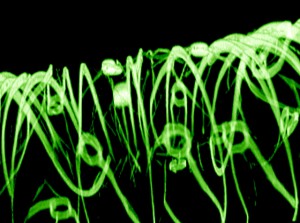Anyone who has difficulty getting or allowing drops into their eyes (I once slid out of an ophthalmologist’s examination chair trying to avoid the eye drops he was administering at the end of my appointment) is going appreciate this Dec. 9, 2013 news item on Nanowerk,
For nearly half a century, contact lenses have been proposed as a means of ocular drug delivery that may someday replace eye drops, but achieving controlled drug release has been a significant challenge. Researchers at Massachusetts Eye and Ear/Harvard Medical School Department of Ophthalmology, Boston Children’s Hospital, and the Massachusetts Institute of Technology are one step closer to an eye drop-free reality with the development of a drug-eluting contact lens designed for prolonged delivery of latanoprost, a common drug used for the treatment of glaucoma, the leading cause of irreversible blindness worldwide.
The Dec. 9, 2013 Massachusetts Eye and Ear Infirmary press release (also on EurekAlert), which originated the news item, notes that a lot of people have problems with eye drops and gives a general description of the research,
“In general, eye drops are an inefficient method of drug delivery that has notoriously poor patient adherence. This contact lens design can potentially be used as a treatment for glaucoma and as a platform for other ocular drug delivery applications,” said Joseph Ciolino, M.D, Mass. Eye and Ear cornea specialist and lead author of the paper.
The contacts were designed with materials that are FDA-approved for use on the eye. The latanoprost-eluting contact lenses were created by encapsulating latanoprost-polymer films in commonly used contact lens hydrogel. Their findings are described online and will be in the January 2014 printed issue of Biomaterials.
“The lens we have developed is capable of delivering large amounts of drug at substantially constant rates over weeks to months,” said Professor Daniel Kohane, director of the Laboratory for Biomaterials and Drug Delivery at Boston Children’s Hospital.
In vivo, single contact lenses were able to achieve, for one month, latanoprost concentrations in the aqueous humor that were comparable to those achieved with daily topical latanoprost solution, the current first-line treatment for glaucoma.
The lenses appeared safe in cell culture and animal studies. This is the first contact lens that has been shown to release drugs for this long in animal models.
The newly designed contact lens has a clear central aperture and contains a drug-polymer film in the periphery, which helps to control drug release. The lenses can be made with no refractive power or with the ability to correct the refractive error in near sided or far sided eyes.
Here’s a link to and a citation for the researchers’ published paper,
In vivo performance of a drug-eluting contact lens to treat glaucoma for a month by Joseph B. Ciolino, Cristina F. Stefanescu, Amy E. Ross, Borja Salvador-Culla, Priscila Cortez, Eden M. Ford, Kate A. Wymbs, Sarah L. Sprague, Daniel R. Mascoop, Shireen S. Rudina, Sunia A. Trauger, Fabiano Cade, Daniel S. Kohane. Biomaterials Volume 35, Issue 1, January 2014, Pages 432–439 DOI: S0142961213011150
This article is behind a paywall.
